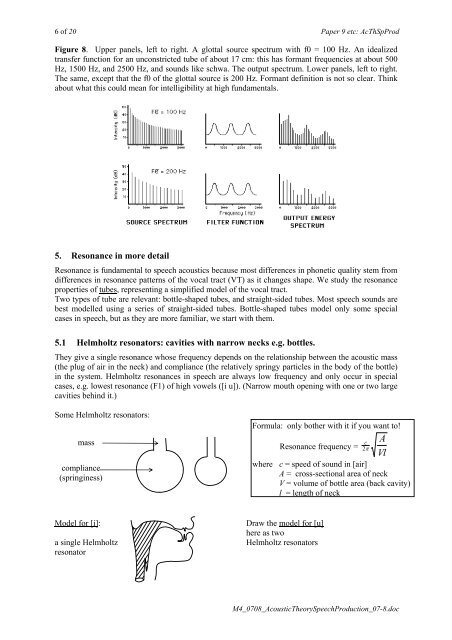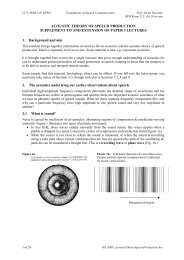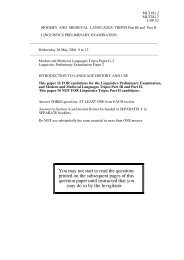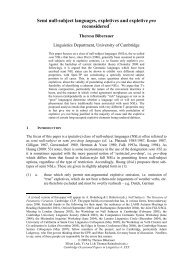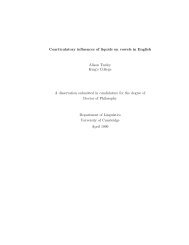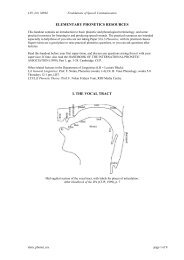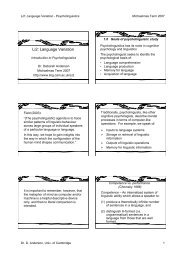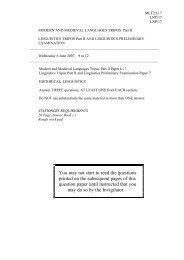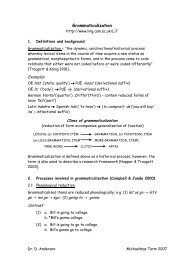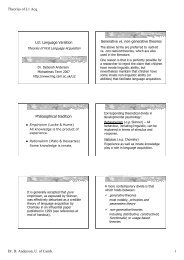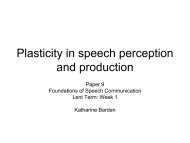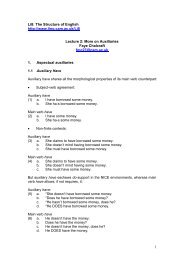ACOUSTIC THEORY OF SPEECH PRODUCTION ... - Ling.cam.ac.uk
ACOUSTIC THEORY OF SPEECH PRODUCTION ... - Ling.cam.ac.uk
ACOUSTIC THEORY OF SPEECH PRODUCTION ... - Ling.cam.ac.uk
You also want an ePaper? Increase the reach of your titles
YUMPU automatically turns print PDFs into web optimized ePapers that Google loves.
6 of 20 Paper 9 etc: AcThSpProd<br />
Figure 8. Upper panels, left to right. A glottal source spectrum with f0 = 100 Hz. An idealized<br />
transfer function for an unconstricted tube of about 17 cm: this has formant frequencies at about 500<br />
Hz, 1500 Hz, and 2500 Hz, and sounds like schwa. The output spectrum. Lower panels, left to right.<br />
The same, except that the f0 of the glottal source is 200 Hz. Formant definition is not so clear. Think<br />
about what this could mean for intelligibility at high fundamentals.<br />
5. Resonance in more detail<br />
Resonance is fundamental to speech <strong>ac</strong>oustics because most differences in phonetic quality stem from<br />
differences in resonance patterns of the vocal tr<strong>ac</strong>t (VT) as it changes shape. We study the resonance<br />
properties of tubes, representing a simplified model of the vocal tr<strong>ac</strong>t.<br />
Two types of tube are relevant: bottle-shaped tubes, and straight-sided tubes. Most speech sounds are<br />
best modelled using a series of straight-sided tubes. Bottle-shaped tubes model only some special<br />
cases in speech, but as they are more familiar, we start with them.<br />
5.1 Helmholtz resonators: cavities with narrow necks e.g. bottles.<br />
They give a single resonance whose frequency depends on the relationship between the <strong>ac</strong>oustic mass<br />
(the plug of air in the neck) and compliance (the relatively springy particles in the body of the bottle)<br />
in the system. Helmholtz resonances in speech are always low frequency and only occur in special<br />
cases, e.g. lowest resonance (F1) of high vowels ([i u]). (Narrow mouth opening with one or two large<br />
cavities behind it.)<br />
Some Helmholtz resonators:<br />
mass<br />
compliance<br />
(springiness)<br />
Formula: only bother with it if you want to!<br />
Resonance frequency = c<br />
2π<br />
A<br />
Vl<br />
where c = speed of sound in [air]<br />
A = cross-sectional area of neck<br />
V = volume of bottle area (b<strong>ac</strong>k cavity)<br />
l = length of neck<br />
Model for [i]:<br />
a single Helmholtz<br />
resonator<br />
Draw the model for [u]<br />
here as two<br />
Helmholtz resonators<br />
M4_0708_AcousticTheorySpeechProduction_07-8.doc


